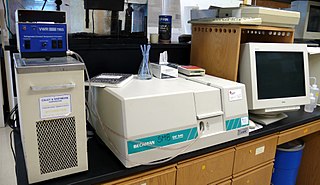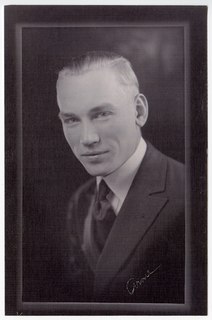
UV spectroscopy or UV–visible spectrophotometry refers to absorption spectroscopy or reflectance spectroscopy in part of the ultraviolet and the full, adjacent visible regions of the electromagnetic spectrum. This means it uses light in the visible and adjacent ranges. The absorption or reflectance in the visible range directly affects the perceived color of the chemicals involved. In this region of the spectrum, atoms and molecules undergo electronic transitions. Absorption spectroscopy is complementary to fluorescence spectroscopy, in that fluorescence deals with transitions of electrons from the excited state to the ground state, while absorption measures transitions from the ground state to the excited state.

Arnold Orville Beckman was an American chemist, inventor, investor, and philanthropist. While a professor at California Institute of Technology, he founded Beckman Instruments based on his 1934 invention of the pH meter, a device for measuring acidity, later considered to have "revolutionized the study of chemistry and biology". He also developed the DU spectrophotometer, "probably the most important instrument ever developed towards the advancement of bioscience". Beckman funded the Shockley Semiconductor Laboratory, the first silicon transistor company in California, thus giving rise to Silicon Valley. After retirement, he and his wife Mabel (1900–1989) were numbered among the top philanthropists in the United States.

Spectrophotometry is a branch of electromagnetic spectroscopy concerned with the quantitative measurement of the reflection or transmission properties of a material as a function of wavelength. Spectrophotometry uses photometers, known as spectrophotometers, that can measure the intensity of a light beam at different wavelengths. Although spectrophotometry is most commonly applied to ultraviolet, visible, and infrared radiation, modern spectrophotometers can interrogate wide swaths of the electromagnetic spectrum, including x-ray, ultraviolet, visible, infrared, and/or microwave wavelengths.

Thomas Eugene Everhart FREng is an American educator and physicist. His area of expertise is the physics of electron beams. Together with Richard F. M. Thornley he designed the Everhart–Thornley detector. These detectors are still in use in scanning electron microscopes, even though the first such detector was made available as early as 1956.

Beckman Coulter Inc. is a Danaher Corporation company that develops, manufactures and markets products that simplify, automate and innovate complex biomedical testing. It is operating in two industries: Diagnostics and Life Sciences. With a history of more than 80 years, the company helps healthcare and laboratory professionals, pharmaceutical and biotechnology companies, universities, medical schools, and research institutions worldwide.

Henry Cary was an American engineer and the co-founder of the Applied Physics Corporation, along with George W. Downs and William Miller. The Cary 14 UV-Vis-NIR and the Cary Model 81 Raman Spectrophotometer were particularly important contributions in scientific instrumentation and spectroscopy. Before starting Applied Physics, Cary was employed by Beckman Instruments, where he worked on the design of several instruments including the ubiquitous DU spectrophotometer. Howard Cary was a founder and the first president of the Optical Society of Southern California.
Applied physics is physics which is intended for a particular technological or practical use.
George W. Downs was an American physicist and corporate officer.

The Spectronic 20 is a brand of single-beam spectrophotometer, designed to operate in the visible spectrum across a wavelength range of 340 nm to 950 nm, with a spectral bandpass of 20 nm. It is designed for quantitative absorption measurement at single wavelengths. Because it measures the transmittance or absorption of visible light through a solution, it is sometimes referred to as a colorimeter. The name of the instrument is a trademark of the manufacturer.
The UCL Mullard Space Science Laboratory (MSSL) is the United Kingdom's largest university space research group. MSSL is part of the Department of Space and Climate Physics at University College London (UCL), one of the first universities in the world to conduct space research. Since its establishment, MSSL has participated in 35 satellite missions, 10 of which are currently in operation, and in over 200 sounding rocket experiments.

The Dobson spectrophotometer, also known as Dobsonmeter, Dobson spectrometer, or just Dobson is one of the earliest instruments used to measure atmospheric ozone.

Bruker Corporation is an American manufacturer of scientific instruments for molecular and materials research, as well as for industrial and applied analysis. It is headquartered in Billerica, Massachusetts, and is the publicly traded parent company of Bruker Scientific Instruments and Bruker Energy & Supercon Technologies (BEST) divisions.

Varian, Inc. was one of the largest manufacturers of scientific instruments for the scientific industry. They had offerings over a broad range of chemical analysis equipment, with a particular focus on Information Rich Detection and Vacuum technology. Varian was spun off from Varian Associates in 1999 and was purchased by Agilent Technologies in May 2010 for $1.5 billion, or $52 per share.

The Science History Institute is an institution that preserves and promotes understanding of the history of science. Located in Philadelphia, Pennsylvania, it includes a library, museum, archive, research center and conference center.
Techtron Appliances was established in 1938 by Mr Geoffrey S.V. Frew, and manufactured electronic equipment to order in North Melbourne, Australia. The name was derived from the words 'Technical' and 'Electronic'.

Mettler Toledo is a multinational manufacturer of scales and analytical instruments. It is the largest provider of weighing instruments for use in laboratory, industrial, and food retailing applications. The company also provides various analytical instruments, process analytics instruments, and end-of-line inspection systems. The company operates worldwide with 70% of net sales, derived in equal parts, from Europe and from the Americas. Asian business is included in the remaining 30%. Mettler Toledo is headquartered in Switzerland and incorporated in the United States.
Max Davis Liston is an American pioneer in the development of instruments for infrared spectrophotometry and non-dispersive infrared analysis. Two of his innovations, the breaker-type direct-coupled amplifier and the vacuum thermocouple, were essential to the development of infrared spectrometry technology. Among others, Liston has developed instruments for capnometry, the measurement of carbon dioxide in respiratory gases, used to monitor patients. He also developed instruments to measure smog and car exhaust emissions, essential to attempts to improve Los Angeles air quality in the 1950s.
R. Robert Brattain was an American physicist at Shell Development Company. He was involved in a number of secret projects during World War II. He is recognized as one of America's leading infrared spectroscopists for his work in designing several models of spectrophotometer, and for using the infrared spectrophotometer to determine the β-lactam structure of penicillin. His instrumentation work was essential to the subsequent study and understanding of structures in organic chemistry.

The DU spectrophotometer or Beckman DU, introduced in 1941, was the first commercially viable scientific instrument for measuring the amount of ultraviolet light absorbed by a substance. This model of spectrophotometer enabled scientists to easily examine and identify a given substance based on its absorption spectrum, the pattern of light absorbed at different wavelengths. Arnold O. Beckman's National Technical Laboratories developed three in-house prototype models and one limited distribution model (D) before moving to full commercial production with the DU. Approximately 30,000 DU spectrophotometers were manufactured and sold between 1941 and 1976.

The Cary Model 14 UV-VIS Spectrophotometer was a double beam recording spectrophotometer designed to operate over the wide spectral range of ultraviolet, visible and near infrared wavelengths (UV/Vis/NIR). This included wavelengths ranging from 185 nanometers to 870 nanometers.


















